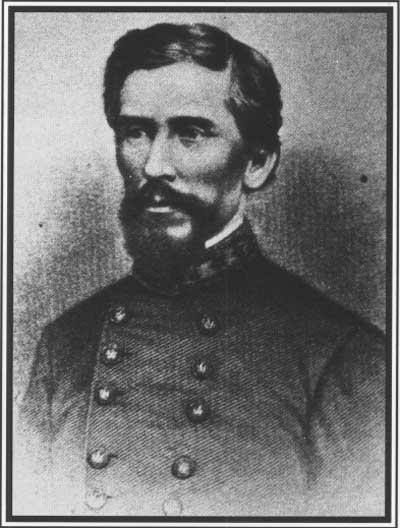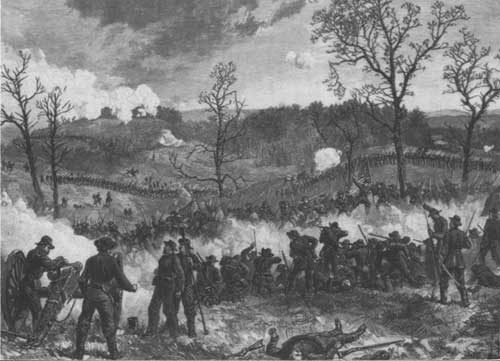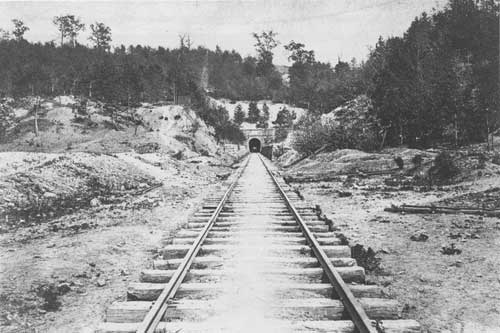|
|
WALKER, THE SOLDIER ARTIST
The striking terrain of the Chattanooga region added a scenic
dimension to the fighting for the Gateway to the Deep South. Lofty
mountains and ridges loomed over the armies, and the heights offered
spectacular views. The November 1863 battles for Chattanooga seemingly
took place in a vast, outdoor arena.
The picturesque potential of the battles on Lookout Mountain and
Missionary Ridge was not lost on one of the mid-nineteenth century's
foremost members of the artistic community—Englishman James
Walker. Born in 1818, Walker came to America with his family in 1824.
At age nineteen, he moved to Mexico and for a time taught art at the
Military College of Tampico. He was living in Mexico City when the
Mexican War began and accompanied the American army as an interpreter in
the Mexico City campaign. His experiences in Mexico led him to produce a
series of paintings chronicling that conflict and brought him national
recognition in the United States as a military artist. Acknowledging his
talents, Walker received a commission to paint a nine-by-nineteen-foot
image of The Battle of Chaputtepec for the United States Capitol.
By the time that work was completed in 1862, the American states were at
war with themselves and Walker had another conflict to record on canvas.
Thereafter, he produced thirty works on the War Between the States
encompassing images of camp life, individuals, and several battles,
including Gettysburg. It was his work with the Battle of Lookout
Mountain or "the Battle Above the Clouds," that gave him lasting
recognition.

|
A JAMES WALKER PAINTING OF UNION OFFICERS DESCENDING LOOKOUT MOUNTAIN
AFTER THE BATTLE. (COURTESY OF THE WEST POINT MUSEUM, US MILITARY
ACADEMY)
|
Walker spent time with the Army of the Cumberland in Chattanooga in
early 1864 and was moved to produce a series of works depicting the
military action in the area. With an eye for detail and accuracy, Walker
carefully studied the battlefields. He walked and rode over the scene
of the engagements, made sketches, and interviewed important Union
participants, such as George H. Thomas, Joseph Hooker, Dan Butterfield,
and John White Geary. He even employed a photographer to produce images
for later reference. "I am confident that I can give our people here to
the North a better idea of what has been accomplished down there than
any report that can be written. No one can describe Lookout in word
painting so as to make it satisfactorily understood," wrote the artist
at the conclusion of his Chattanooga visit. From these sources, Walker
first produced The Battle of Chickamauga and The Battle of
Lookout Mountain (see back cover), both commissioned by the United
States government. Later, he also produced Mounted Union Officers on
Lookout Mountain, Union Cavalry on Lookout Mountain, and another
version depicting the battle itself.
Walker's second image of the Battle of Lookout Mountain was his
largest work and is considered by many to be his masterpiece.
Commissioned by "Fighting Joe" Hooker to commemorate that general's
part in "The Battle Above the Clouds," this second Battle of Lookout
Mountain (see below) covers a thirteen-by-thirty-foot canvas and was
produced for $20,000 over a four-year period. Upon completion in 1874,
the painting toured the country with stops in New York, Philadelphia,
and San Francisco. Hooker said of Walker's grandest work, "I wanted it
to be the representation of an American battle as it was. . . . You
appear to have adhered to the instructions with singular fidelity and
success. It is unnecessary for me to speak of the landscape, except in
terms of the highest approval. . . . I am equally gratified with the
representation of the dramatis personae on your canvas. While later
generations of art and military historians would acknowledge greater
artistic license than did Hooker, The Battle of Lookout Mountain
is one of the most visually significant documents on that important
engagement.

|
JAMES WALKER'S SECOND VERSION OF THE BATTLE OF LOOKOUT MOUNTAIN.
(NPS)
|
Following the completion of The Battle of Lookout Mountain,
Walker turned his artistic attention to a new American arena, the West.
Moving to California in 1876, Walker produced more than thirty images of
Western life and California scenes before dying in 1889 at age 70.
|
Back at the Gillespie house, Stevenson and Jackson waited patiently
for Cheatham to return. It was well after midnight when a courier from
Bragg galloped up and announced that all troops west of Chattanooga
Creek were to start at once for the far right of the army. No one could
find Cheatham so Stevenson took responsibility for the move. Up on the
frigid slope of Lookout Mountain, the firing died out a little after
midnight.
Hooker's success on Lookout Mountain was of little interest to Grant.
In his view, Sherman's march against Bragg's right was the real battle,
and on it he pinned his hopes. As darkness fell on November 24, Grant
believed his faith in his friend vindicated. Sherman assumed he had
carried Tunnel Hill, and Grant based his planning on the impression that
Sherman need only press his advantage at daybreak to roll up Bragg's
flank and complete his victory.
Grant's instructions to Sherman were simple: he was "to attack the
enemy at the point most advantageous from your position at early dawn."
To Thomas went a supporting role: "I have instructed Sherman to advance
as soon as it is light in the morning, and your attack, which will be
simultaneous, will be in co-operation. Your command will either carry
the rifle-pits and ridge directly in front of them or move to the left,
as the presence of the enemy may require."

|
HOOKER SITS ATOP THE CONQUERED POINT LOOKOUT. (USAMHI)
|

|
GENERAL THOMAS (SECOND FROM LEFT) AND HIS STAFF ON POINT LOOKOUT IN
1863. (LC)
|
Grant envisioned no serious role for Hooker; at best his was to
divert Bragg's attention from his right flank by a further display on
Lookout Mountain.
But Thomas flouted Grant's directive. He called Hooker down to the
valley, where he could make a more tangible contribution by
demonstrating directly against Bragg's left flank on Missionary Ridge.
Also, Thomas wanted to ensure that his own right was protected.
By 10:00 A.M., when Hooker got started, Thomas was feeling much
relieved. A stunning revelation had compelled Grant both to endorse
Thomas's orders to Hooker and to postpone Thomas's own advance toward
Missionary Ridge. When the morning fog burned off, Grant and his staff
realized that Sherman did not hold Tunnel Hill, which bristled with
Confederate cannon and toward which long lines of Rebel infantry were
marching. Grant, Thomas, and their staffs waited on Orchard Knob with
ill-concealed impatience for Sherman to go into action.
But Sherman was in the throes of indecision. Dawn found him no more
capable of grasping the reality of the Confederate presence on Tunnel
Hill—or of overcoming it—than he had been at sunset the day
before. Neither did he appreciate the overwhelming superiority he
enjoyed: facing Sherman's four divisions (16,000 men) was Cleburne's
three small brigades, numbering 4,000. And only Smith's Texas brigade
actually stood atop Tunnel Hill.
Yet Sherman hesitated. Not until 8:00 A.M., ninety minutes after
Sherman should have launched his attack, did his weary men finally
receive orders to quit fortifying their fronts. He finally decided to
strike Tunnel Hill simultaneously from the north and northwest with just
two brigades: those of John Corse and John Loomis of Ewing's division.
Corse would come at Tunnel Hill from the northwest. Loomis, on his
right, was to approach Tunnel Hill through the open fields between the
railroads. To John Smith and Morgan Smith went ill-defined supporting
roles; to Jefferson C. Davis went no role at all.

|
A DECEMBER 1863 VIEW OF A RAILROAD BRIDGE OVER CHATTANOOGA CREEK. (LC)
|
The results of Sherman's poorly planned assault were predictable.
Corse ran up against Tunnel Hill with only 920 men and was decimated in
two successive charges. Before making a third, Corse wanted to know if
Sherman wanted him to try again. "Go back and make that charge
immediately; time is everything," Sherman snarled.
Sherman's dawdling was Cleburne's salvation. Every minute the Ohioan
delayed brought the Irish immigrant vital reinforcements. The first came
just after sunrise, when Brigadier General John Brown's Tennesseans
staggered into position. With infantry on hand to support them, the
batteries of Calvert and Goldthwaite were wheeled into place above the
tunnel. Cummings brigade showed up next and was fed into line to the
left of Brown. Lewis's Orphan Brigade reported to Cleburne next.
Cleburne left him behind Smith, on the eastern slope of Tunnel Hill, as
a reserve.
At 10:30 A.M., Sherman's cannon unleashed a barrage on Smith's
Texans. Behind the exploding shells came Corse's infantry. Lieutenant H.
Shannon, in command of Swett's battery atop Tunnel Hill, wheeled his
guns to face the bluecoats. He shredded their ranks with canister, but
the Yankees kept coming. They charged to within fifty feet of Smith's
line before breaking. Smith was dangerously wounded, and brigade command
passed to Colonel Hiram Granbury.

|
MAJOR GENERAL PATRICK R. CLEBURNE (USAMHI)
|

|
ALFRED R. WAUD'S POSTWAR DRAWING OF CLEBURNE'S REPULSE OF SHERMAN AT
MISSIONARY RIDGE. (NPS)
|
Corse had attacked with only a part of his brigade. Before trying
again, he called up the remainder and sent to Sherman for help.
But Corse had no intention of waiting for reinforcements before
attacking a second time. Placing himself in the front line, at 11:30
A.M. Corse ordered an advance. This time the Yankees came within a few
feet of the enemy works before giving way. Corse fell, slightly wounded.
While he was carried to the rear, his troops kept up the pressure on the
Texans, holding onto the northern slope of Tunnel Hill with a rabid
tenacity.
Cleburne worked feverishly to dislodge the Federals. He positioned
Douglas's battery near Granbury's right flank to enfilade the Yankee
left, then called forward two of Lewis's regiments to extend his line
eastward.
When the Federals at last gave way, the Texans surged over their
breastworks and into the ravine after them. Regrouping on the rise north
of Tunnel Hill, the Yankees beat back the counterattack. Colonel
Charles Walcutt, assuming command from Corse, appealed to Sherman for
orders.
Sherman had had enough. Corse's setback convinced him that the
northern approach to Tunnel Hill was bankrupt so he refused to send
Walcutt reinforcements, telling him simply to hold his ground. For all
practical purposes, the first Federal effort to take Tunnel Hill was
over at noon.
How was it that Cleburne had been free to turn his undivided
attention to pulverizing Corse's brigade? Largely because Loomis had
taken literally General Ewing's admonition that he "under no
circumstances" bring on a general engagement, marching his brigade only
as far as the edge of the woods. Nearly half a mile of meadows and soggy
fields lay between Loomis and the railroad tunnel, on top of which
Cleburne's artillery stood, ground Loomis was averse to cross.
At 10:30 A.M., Loomis was handed unexpected orders. Corse was about
to assault Tunnel Hill, and Loomis was to advance at once in
cooperation. Loomis made a good faith effort at complying, but he had no
idea where Corse's flank lay or when or in what direction Corse might
attack. So Loomis moved out blindly. Guiding on the mouth of the tunnel,
he opened a gap of 400 yards between his left and Corse's right.
Loomis never had a chance. The instant his men stepped into the
clear, they were easy marks for the two batteries atop the tunnel. The
Yankees made it as far as the railroad embankment at a point where it
curved south.
Loomis was in trouble. His three regiments behind the embankment were
leaking wounded rearward at an alarming rate, and his left-flank
regiment, the Ninetieth Illinois, had the impossible duty of trying to
make the connection with Corse. The brigade had strayed too far south,
and the Ninetieth had lost so many men that it covered a front barely
the width of two normal-sized companies. Worse yet, Cleburne had pushed
two regiments off Tunnel Hill and onto the flat near the Glass farm,
opposite the left flank of the Ninetieth Illinois.
After thirty minutes in this untenable position, Loomis summoned two
regiments to roust the Confederates from the farm. Lieutenant Colonel
Joseph Taft of the Seventy-third Pennsylvania led his own regiment and
the Twenty-seventh Pennsylvania across the flat on the run, sweeping the
Rebels from the Glass farm. Taft ordered a halt at the foot of Tunnel
Hill, but his order was misunderstood, and the Twenty-seventh
Pennsylvania continued upward to within thirty yards of the hilltop.
Back on the flat, Loomis imagined that the Confederates were
preparing to sally forth of Tunnel Hill into the gap that Taft had
failed to close. Desperate to forestall an attack, Loomis again pleaded
for reinforcements. Again only a single brigade was sent to bolster the
flagging Federal attack. This time the duty fell to Brigadier General
Charles Matthies. Confederate artillery pulverized his brigade as it
crossed the flat, and the survivors took cover along a sunken wagon
road.
As his brigade sorted itself out, Matthies realized that he had
veered too far to the left to cover Loomis's flank. In an effort to
close the gap, he ordered the Tenth Iowa from the foot of Tunnel Hill
over to the far right. Colonel Holden Putnam, the commander of the
Ninety-third Illinois, led his regiment up the hill at full tilt.
Putnam was shot dead and his Illinoisans were stopped thirty yards from
the crest. Regrettably, General Matthies chose to reinforce what clearly
was a losing proposition, sending all but the Fifth Iowa up to bolster
the Ninety-third Illinois. Matthies went up himself a few minutes later,
only to be struck by a bullet in the head. In the distance was another
double line of blue sweeping across the flat, alone and unsupported. It
was the brigade of Brigadier General Green Raum, whom Sherman committed
to the stalled attack against Tunnel Hill at 2:00 P.M. By the time Raum
reached Tunnel Hill, the situation along Matthies's front had
deteriorated beyond repair. In hopes of reversing the tide, Raum sent
two of his regiments up the hill.
Cleburne was in trouble. With Raum's two fresh regiments about to hit
his front, Corse's Federals plunking away at his right flank, and the
ammunition of his men down to only a handful of cartridges, it looked
for the first time that afternoon as if Cleburne's salient might be
broken.

|
THE EAST TENNESSEE AND GEORGIA RAILROAD PASSES THROUGH MISSIONARY RIDGE
AT TUNNEL HILL. (LC)
|
But fortune favored the Irishman. General Hardee had plied Cleburne
with reinforcements. With the advantage of interior lines and easy
ground to traverse, the Rebels could marshal troops on and near Tunnel
Hill far faster than Sherman's disorganized generals could bring units
to bear against it. Cleburne fed fresh troops into the line just as
Raum's two regiments charged past Matthies's stalled brigade. After Raum
was halted, Cleburne ordered a counterattack all along the line.
The effect was electric. The Rebels bounded down the slope at 4:00
P.M. So spontaneous did the effort seem that some participants swore no
order was ever given to charge.
After three nerve-wracking hours, the Federals had neither the
strength nor the ammunition to resist. Yankees surrendered by the
score, and the survivors slipped across the flat to safety. General John
Smith was on hand to greet them, "smoking a pipe as calmly as he would
in camp," reflected a begrimed survivor. "Well, boys, that's a tough
place up there," he laughed. His joke fell flat, and the men drifted
past in sullen silence.
So ended one of the sorriest episodes in this or any other battle of
the war. In his assault on Tunnel Hill, Sherman exhibited an egregious
lack of imagination. He attacked Cleburne's salient head-on and with
only a fraction of his force, rather than look for a way to outflank
Tunnel Hill.
|
|
